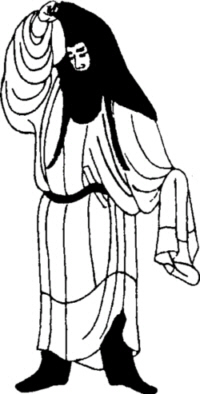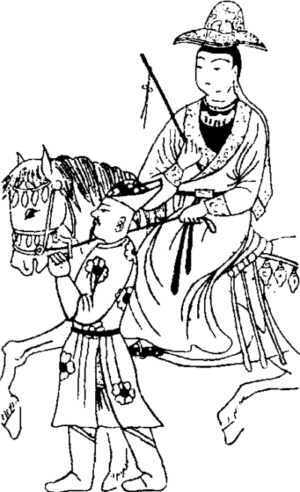Chapter 23 Hu clothing in the fourth quarter
The Tang Dynasty was the era when Hufu flourished.The capital, Chang'an, was a world-renowned city at that time, and it was the center of economic and cultural exchanges between the East and the West. Many countries communicated with the Tang Dynasty.In addition to the Han Chinese, the residents of Chang'an also included Huihe [hehe] people, Qiuci [qiuci Qiuci] people, Japanese, Silla people, and Persians.The inland Han people also had frequent exchanges with the ethnic minorities in the Northwest and the people of the East and West.If we say that the great clothing exchange in the past was mostly north-south, then the Tang Dynasty clothing exchange was mainly east-west, which is unique and more distinctive.This is because the water and land transportation in the Tang Dynasty was quite developed.The prosperous economy and developed culture of the Tang Dynasty were extremely attractive to the Eastern and Western countries.Therefore, this exchange of clothing culture has become an inevitable trend of history.
Judging from the unearthed cultural relics (especially paintings, sculptures, etc.) of the Tang Dynasty, most of the Hufu worn by women in the Tang Dynasty were brocade hats, narrow-sleeved gowns, striped trousers, and soft brocade boots.Most of the jackets have double fronts, lapel collars, narrow sleeves, and a wide brocade border on the cuffs, collars, and skirts.There are two types of mili in Hu clothing: one is a large square scarf, made of light and transparent gauze, which is wrapped around the body and covers the whole body; Garments like cloaks.This clothing may be related to Arabian attire.Due to the strong wind and sand in the northwest, people use it to cover their bodies when they travel and ride horses to hide the wind and dust.Some people think that only when women travel far away, do they put their hands on their hands (up and down), so as not to be peeped by men.Some people also think that it is a uniform for men and women.In the Tang Dynasty painting "Figures under the Tree" collected by the Tokyo National Museum in Japan, a woman raises her left hand high to remove the veil covering her head.This kind of mask is made of black cloth, about the length of the chest, with a ribbon on the left and right hanging down to the waist, and a round hole on the face for easy viewing.This is the female image of Dai Mi (Up and Down Li).By the time of Emperor Gaozong of the Tang Dynasty, more and more Han women wore veiled hats, which gradually replaced Mi (upper furnishing and lower disengagement). "New Tang Book·Car Clothes" said: "In the early days, women Shi Mi (upper and lower) to cover their bodies, and in Yonghui (Tang Gaozong's reign), they began to use curtain hats." , a wire mesh hat with a drooping brim.It has more advantages than Mi (上罒下离): first, it is easy to wear and take off, unlike Mi (上罒下去) which covers the head to the chest; second, it has a more beautiful appearance; It can be lifted.The abolition of power (upper fur and lower disengagement) and the revival of the curtain hat reflect women's awareness of getting rid of shackles, pursuing nature and paying attention to practicality in the Tang Dynasty.When it came to Wu Zetian, no matter the ladies of the court or the women of the common people, they often wore veiled hats when they went out on horseback.It can be said that "the curtain and hat are popular, and the power (upper and lower) gradually fades away" ("Old Tang Book · Yufu Zhi").

Women of the Tang Dynasty Dai Mi (Shang Fu Xia Li)
Regarding the dissemination process of Hufu, relevant experts believe that Hufu in the Tang Dynasty can be divided into early and late periods.In the early period, Hu clothing came directly from the Western Regions and indirectly from Persia. Its clothing was characterized by wearing a hat, a shirt with round collar or lapel collar, striped trousers, and brocade [yao medicine] boots with hollow soft soles.Huntuo hat is a felt hat made of black sheepskin, with a high top, pointed and round.In the later period, Hufu came from Tubo [bobo], mainly referring to the makeup of the times.It is characterized by women's pretty hair in a bun, double eyebrows in a horoscope and low frown [pin frequency], gold powder on the face, and black ointment on the lips.Bai Juyi in the Tang Dynasty described the makeup of the times: "Small-headed shoes and narrow clothes, Qingdai dotted eyebrows and slender eyebrows. Outsiders should laugh when they don't see them, Tianbao's makeup in the last years of the world." ("Changqing Collection·Shangyang White-haired Man" ) In the Tang Dynasty, Hufu, Huzhuang, Hule, Huwu, and Hushi were all the rage, which added a lot of fun to the court life at that time and enriched a lot of content for social life.According to historical records, Changshan minwang Li Chengqian was established as the crown prince by Tang Taizong. When he lived in the East Palace, "dozens of household slaves were made to learn the voice, imitate the barbarians' buns, and cut them into dance clothes... drums [pi skin, The sound of a kind of drum continues day and night." ("New Book of Tang Changshan King Biography")

Hun Takes Off His Hat (Dunhuang Mural Painting)

Women of the Tang Dynasty Dai Mi (Shang Fu Xia Li)

Hun Takes Off His Hat (Dunhuang Mural Painting)
